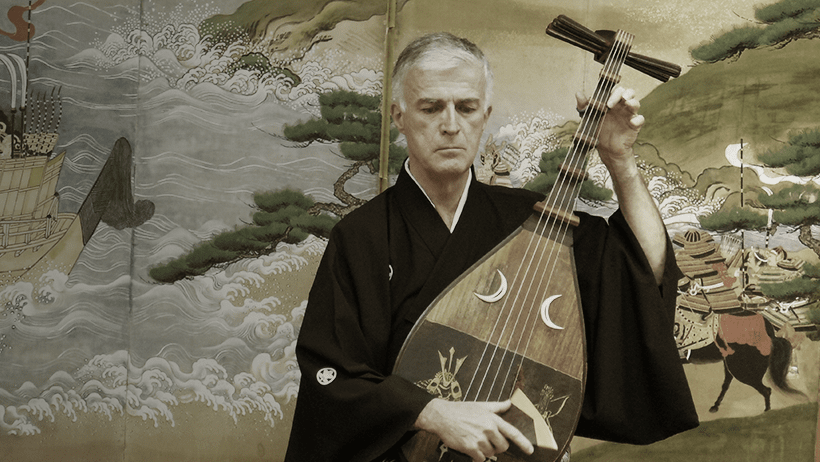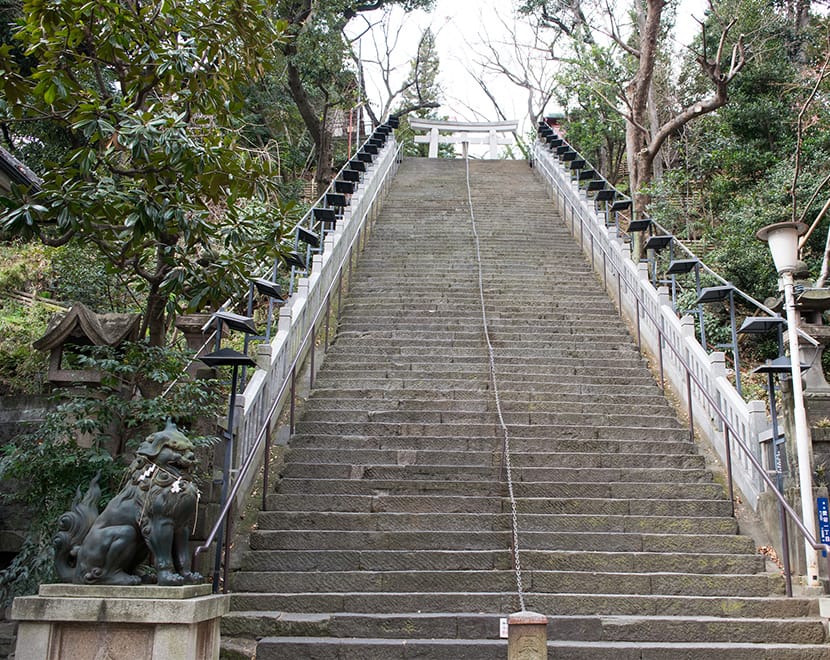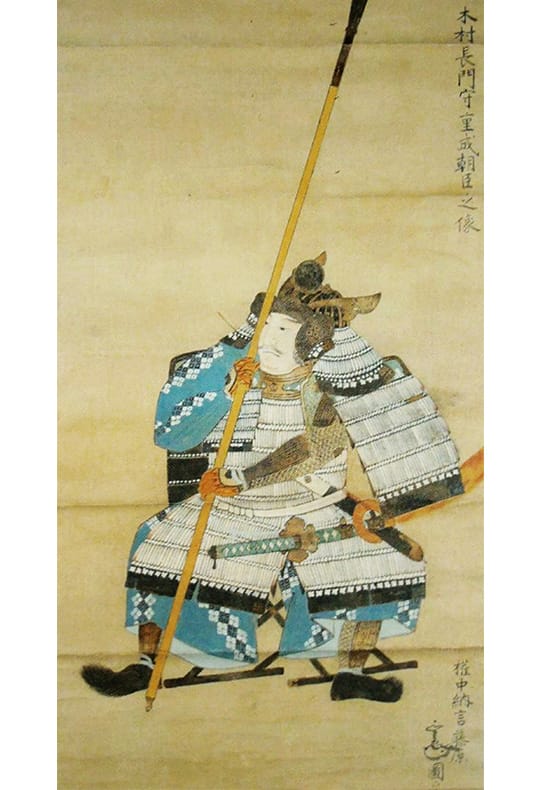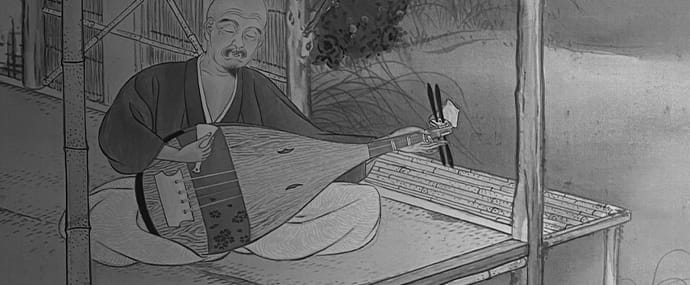
magaki heikuro
曲垣平九郎

Introduction
This ballad is among the most brilliant pieces in the repertoire, although for the Western audience, it may be seen as perhaps grim. The Japanese audience, however, has a different perception of the plot, and particularly the characters of this story.
The most problematic personage at the center of the ballad is shogun Iemitsu. For Westerners, his behavior appears unquestionably sadistic, as he knows very well how dangerous it is to ride a horse up the steep steps of Atago Hill, a 40 degrees incline. Despite two horsemen having taken fatal falls, he nevertheless insists, and vehemently, on having his wish fulfilled.
Documents attest to Iemitsu’s having had a brutal character. He apparently supported junshi (ritual suicide on the death of one’s lord), which his successor, the shogun Ietsuna, abolished. When Iemitsu died, thirteen of his retainers followed him in death. During Iemitsu’s rule, the country was largely closed to the outside (sakoku), and the earlier ban against Christianity was again strictly enforced. In the Christian related Shimabara revolt of 1637-38, approximately 37,000 people were slaughtered on his command. The most brutal and restrictive aspects of the TOKUGAWA reign appeared under Iemitsu. Nevertheless, in Japanese mainstream historiography, he remains seldom subjected to moral criticism.
Synopsis
On a spring day, the shogun, TOKUGAWA Iemitsu, after visiting the San’enzan Temple with his main vassals, passed by close by the Hill Atago on his return, where he spotted a beautiful blooming cherry tree. He longed to experience its splendor and stated his desire to have a branch brought to him. Iemitsu thought that one of his attendant horsemen should ride up the stairs and pick the branch for him. This, however, was clearly a very dangerous task, not only for the horse, but also for its rider.
All of his followers felt most uncomfortable with the idea of risking their lives and the lives of their horses to satisfy the capricious whim of the shogun. With this, however, Iemitsu became extremely angry, and one of the attendants, YAMAMOTO Ukyō Tadashige, attempted the task. After twenty steps, however, the horse stumbled and he fell to his death.
The next to volunteer was TORII Kiichirō Shigefusa, who managed to go halfway up the stairs at which point his horse fell, and fatally injured its rider.
The second death enraged Iemitsu, and he shamed everybody by moving to do it himself. At this moment, however, ŌKUBO, his venerated adviser, stepped forward and stopped him with the argument that such an important figure as the shogun should not take such risks. He proposed, despite his age, to ride up the stairs on the shogun’s behalf.
With this, however, another samurai, MAGAKI Heikurō Morizumi, broke from the horsemen’s ranks and positioned himself in front of ŌKUBO. Although concerned about his low status, he nonetheless asked for permission to attempt the ride up the stairs. Iemitsu beamed, and commented that such a task was not restricted to rank, but relied solely upon the horseman’s ability.
The core of the ballad focuses upon Heikurō as he prepares the horse and himself for the ride. He paces to and fro on his steed gazing at the hill, and pondering how to successfully ride his horse up the steep stairs. He focuses intently and slowly moves upwards step by step. Halfway up the stairs, it appears as if his body suddenly vanished. He had, however, slid to down to the horse’s underside from where he manually guided the two front legs of the horse ensuring that each step is securely placed. With this, the horse does not stumble and they safely reach the top of the hill. There, to the wonderment of all, Heikurō reappears, breaks off the coveted branch from the cherry tree, and makes the return ride on the gentle downward path known as “Lady-Hill”. Arriving in front of Iemitsu, he leaps from his horse, presents the branch to the shogun, and prostrates himself. Iemitsu smiles and pronounces him the finest horseman in all Japan.

Lyrics
-
1. From order to chaos, Aus der Ordnung in die Wirren,
Chi yori ran ni iri 治より乱に入り
-
2. and from chaos to order. aus den Wirren in die Ordnung,
ran yori chi ni iri 乱より治に入り
-
3. The dreams of the Genki and Tenshō eras have passed, wie im Traum verging die Zeit der Genki- und der Tenshō-Jahre.
Genki Tenshō mo yume to sugi 元亀天正も夢と過ぎ
-
4. and the spring breezes of the Kan’ei era now blow. In der Welt der Kan’ei-Ära weht ein Frühlingswind.
yo wa Kan’ei no harukaze ya 世は寛永の春風や
-
5. The shogun – the lord of lords Der Shogun, welch ein Herr –
mi wa ryūei no shū to shite 身は柳営の主として
-
6. shining mightily throughout the land – im ganzen Lande machtvoll strahlend –
ibu hakkō ni kagayakishi 威武八荒に耀きし
-
7. is the young and spirited Iemitsu. ist der junge Iemitsu.
nenshō kiei no Iemitsu wa 年少気鋭の家光は
-
8. Escorted by three hundred lords, Mit dreihundert fürstlichen Vasallen im Gefolge
sanbyaku shokō o hikigu nashi 三百諸侯を引具なし
-
9. his whip cracked majestically, reitet er, die Peitsche knallend, würdevoll
bensei ito mo shukushuku to 鞭声いとも粛々と
-
10. on his return from the San’en Temple, zurück vom San’en Tempel.
san’enzan no kaerusa ni 三縁山のかへるさに
-
11. when he gazed up and saw the cheery tree on Atago Hill. Plötzlich sieht er auf dem Hügel Atago
aogu Atago no yamazakura 仰ぐ愛宕の山ざくら
-
12. Atop the soaring flight of steps Kirschbäume in der Blüte.
takaku sobadatsu kizahashi no 高く岨立つ磴道の
-
13. was a single crowning branch, Steil hinauf führt eine Treppe,
ue ni kazaseru hitoeda wa 上に翳せる一と枝は
-
14. its mysterious blossoms wo ein Zweig, fein rosa schimmernd,
hana no fuzei mo ito tae ni 花の風情もいと妙に
-
15. profoundly elegant. tief sein Herz bewegt.
kokoro nikuku zo mienikeru 心憎くぞ見えにける
-
16. What could Iemitsu have been thinking when he said, Doch was geht in ihm jetzt vor, wenn er befiehlt:
nani omoiken Iemitsu wa 何に思ひけん家光は
-
17. “Someone on horseback, „Es soll mir einer auf dem Pferd
tazo aru uma nite 誰ぞある馬にて
-
18. ride up those stone steps, erklimmen diese Stufen
kono ishidan o kakenobori 此の石段を駆け上り
-
19. and fetch me that branch!” und den Zweig dort oben holen.“
ano eda totte maireyo to あの枝取って参れよと
-
20. And with these words, the lined lords Als die Reiter aller Ränge diesen Wunsch vernehmen,
ōse ni namiiru shodaimyō 仰せに並居る諸大名
-
21. and the shogun’s vassals schauen sie
shitagō fudai no hatamoto mo 従ふ譜代の旗本も
-
22. looked at each other, verlegen drein.
tagai ni kao o miawasete 互に顔を見合せて
-
23. for to die in battle, In einer Schlacht zu sterben,
yumiya no uchi ni shisunaraba 弓矢の中に死すならば
-
24. was something to which they could resign themselves, das gereicht ja wohl zur Ehre,
kanete kakugo no koto naredo 予て覚悟の事なれど
-
25. but for capricious words, aber wegen einer Laune nur,
kakaru zare naru kotonoha ni 斯る戯なる言の葉に
-
26. the lamentable act of throwing away one’s life, den Kopf aufs Spiel zu setzen,
suten inochi no oshimarete 捨てん命の惜まれて
-
27. there was no immediate response. lässt sie ohne Antwort bleiben.
tomi ni irae mo nasazariki 頓に返辞もなさゞりき
-
28. Iemitsu grew impatient, Iemitsu wird nun ungeduldig.
Iemitsu kokoro sekitatete 家光こゝろ焦立てゝ
-
29. “Come now!” he urged them. „Los, was ist denn!“ ruft er ungehalten.
ikani ikani to unagaseba 如何に如何にと促せば
-
30. His command was now unavoidable, Also gilt die Forderung für jeden,
taimei ima wa zehi mo naku 台命今は是非もなく
-
31. for the honor of those in his service. denn es geht um den Gehorsam.
tsukōru shū no menmoku ni 仕ふる主の面目に
-
32. The one who cried, “Allow me this service!” Einer ruft: „So will ich es denn wagen!“
ware tsukamatsuran to tachiizuru wa 吾れ仕らんと立出づるは
-
33. was the cavalry captain of the TŌDŌ clan in Ise, Im TŌDŌ Haus in Ise ist er Reitschulmeister:.
Ise TŌDŌ no bajutsu shinan 伊勢藤堂の馬術指南
-
34. YAMAMOTO Ukyō Tadashige. YAMAMOTO Ukyō Tadashige.
YAMAMOTO Ukyō Tadashige nari 山本右京忠重なり
-
35. He gripped the reins of his horse, Er strafft die Zügel seines Pferdes,
koma no tazuna o hikishimete 駒の手綱を引締めて
-
36. and valiantly urged it on with “hai yo, hai yo!” „haiyō, haiyō!“ feuert er es an.
hai yo hai yo to isamashiku はいよはいよと勇ましく
-
37. Only to climb some twenty steps, Die ersten zwanzig Stufen hat er hinter sich gebracht;
nijūyodan noborishi toki 二十余段上りしとき
-
38. when the horse misplaced a foreleg, doch nun verfehlt sein Pferd mit einem Vorderlauf die Stufe,
uma wa maeashi fumihazushi 馬は前肢踏みはづし
-
39. and tumbled, crashing down the steps. und schon stürzen Ross und Reiter fürchterlich.
dōto bakari ni ochinikeri どうと計りに落ちにけり
-
40. The next to venture forth, Der nächste, der es wagt,
tsuzuite makari idetaru wa 続いて罷り出でたるは
-
41. and well-known by the Akita SATAKE clan, stammt aus dem Akita SATAKE Haus,
Akita SATAKE ni shiraretaru 秋田佐竹に知られたる
-
42. was TORII Ki’ichirō Shigefusa. TORII Kiichirō Shigefusa genannt.
TORII Kiichirō Shigefusa nari 鳥居喜一郎重房なり
-
43. Sure of himself, he raised his whip, Er ist sich seiner Sache sicher, knallt die Peitsche,
ude ni oboe no muchi o age 腕に覚えの鞭を揚げ
-
44. and “dō dō dō”, he rumbled up the steps. reitet dō-dō-dō im Sturm hinauf.
dō dō dō to kakenoboru どうどうどうと駆け上る
-
45. But as all were watching this, Es folgen ihm die Blicke eines jeden,
kore wa ikani to miru uchi ni 之は如何にと見る中に
-
46. Half-way up, he crumbled and fell! aber mitten in der Treppe stürzt er krachend hin.
ishidan nakaba ni kuzureotsu 石段半途に崩れ落つ
-
47. Iemitsu was enraged, Dies macht nun Iemitsu zornig.
Iemitsu katto ikarase tamai 家光嚇と怒らせ給ひ
-
48. “I shall ascend the stairs myself „Muss ich selber hoch die Stufen reiten,
ide kono ue wa mizukara ga いで此の上は自らが
-
49. for the blessings of the warrior”, um die Ritterehre noch zu retten?“
bumon no myōga ni noboran to 武門の冥加に上らんと
-
50. and impatiently started to move when ŌKUBO Aufgeregt und voller Sorge
hayarase tamō wo ŌKUBO wa 逸らせ給ふを大久保は
-
51. suddenly stepped in front of his horse. wirft sich ŌKUBO jetzt vor ihn hin:
bazen ni hata to tachifusagari 馬前にハタと立塞がり
-
52. “The priceless child should not die for such impetuousness. „‘Ein edles Kind darf nicht auf einem Marktplatz sterben’.
senkin no ko wa ichi ni shisezu 千金の子は市に死せず
-
53. You must at all costs desist from this. Ungeduld soll euch nicht ins Verderben stürzen.
kanarazu tanryo na shitamai so 必ず短慮な仕給ひそ
-
54. Although I am old Alt geworden bin ich zwar,
ware oitari to mōsedomo 吾れ老ひたりと申せども
-
55. allow me do it in your honorable stead.” doch lasst an eurer Statt mich reiten“;
kimi ni kawatte tsukamatsuran to 公に代って仕らんと
-
56. and he prepared himself in haste. eilig traf er Vorkehrungen.
isogi yōi zo nashitarikeru 急ぎ凖備ぞなしたりける
-
57. Now, to the front of ŌKUBO, Da, auf einmal trat vor ŌKUBO
kono toki bazen ni kakeideshi wa 此時馬前に駆け出でしは
-
58. A sole warrior in his thirties advanced, ein dreißig Jahre alter Reiter hin
misoji ni amaru bushi hitori 三十路に余る武士一人
-
59. his face brimming with sincerity. mit einem lauteren Gesicht.
magokoro omote ni arawashite 赤心面にあらはして
-
60. once he arrived in front of Hikoza, he said, Wie er vor Hikoza steht, spricht er mutig:
Hikoza ga mae ni mōsu yō 彦左が前に申すやう
-
61. “I am from Sanshū, „Aus dem Lande Sanshū komme ich
soregashi koso wa Sanshū no 某こそは讃州の
-
62. and a retainer of IKOMA Shōgen. und bin Vasall von IKOMA Shōgen.
IKOMA Shōgen ga kashin naru 生駒将監が家臣なる
-
63. My name is MAGAKI Heikurō Morizumi. Mein Name ist MAGAKI Heikurō Morizumi.
MAGAKI Heikurō Morizumi nari 曲垣平九郎盛澄なり
-
64. Despite my humble rank as a rear retainer, Mein Rang ist zwar nur niedrig,
baishin no mi no osore nagara 陪臣の身の恐れながら
-
65. your request should be accomplished. Aber was Er fordert, will ich gern erfüllen,
ōse o hatashi sōrō beshi 仰せを果し候べし
-
66. Please, convey my wish to his lordship.” bitte, tragt Ihm meinen Wunsch doch vor.“
kami e ontorihakarai negawan to 上へ御取計ひ願はんと
-
67. Upon hearing this, Iemitsu rejoiced, Als Iemitsu dies vernimmt, ist seine Freude groß.
kiku yori Iemitsu yorokobite 聞くより家光喜びて
-
68. “In the path of the warrior, there is no rank. „Der Pfad des Ritters kennt nicht Rang und Namen,
budō ni jōge no hedate nashi 武道に上下の隔てなし
-
69. Make haste!” he said. schnell, erfülle meine Forderung!“
toku tsukamatsure to ōsekeru 疾く仕れと仰せける
-
70. Morizumi answered with a shout of agreement, „Ha!“ ruft Morizumi ihm zur Antwort,
hatto kotaete Morizumi wa ハッと答へて盛澄は
-
71. And onto his sturdy dappled horse, und auf seinen stolzen Apfelschimmel,
renzen ashige no takumashiki 連銭葦毛の逞ましき
-
72. a spirited steed, auf das Lenzen-Ross, das feurig-wilde,
hayari ni hayaru harukoma ni 逸りにはやる春駒に
-
73. he leapt. In front of the stone steps, schwingt er sich behende. Vor der Treppe
uchimatagarite ishidan no 打跨りて石段の
-
74. they circled twice, nay, even thrice. dreht er zwei, drei Kreise –
mae ni nisando wa o egaki 前に二三度輪を描き
-
75. Both horse and horseman gazed mehrmals richten Pferd und Reiter ihre Blicke
uma hito tomo ni ikutabi ka 馬人共に幾たびか
-
76. their eyes travelling several times up and down the hill of Atago. auf den Hügel Atago – hinauf, hinunter,
miage miorosu Atago yama 見上げ見下す愛宕山
-
77. The time is now, and he raised his whip, bis die Zeit gekommen ist: „Hopp!“ die Peitsche knallt,
jibun wa yoshi to muchi o age 時分はよしと鞭をあげ
-
78. and cried, “Hai dōdō!” „Ja!, dō, dō!“ ruft er;
hai dōdō no kakegoe ni はいどうどうの懸声に
-
79. With clattering hooves, katsu-katsu, und die Hufe klappern katsu-katsu,
hizume no hibiki katsukatsu to 蹄の響かつかつと
-
80. up and up they go. hoch, hoch hinauf geht es mit beiden.
ue e ue e to noboriyuku 上へ上へと登り行く
-
81. All were gazing in wonder, Was denn, was denn? Alle sind verblüfft,
are yo are yo to miru uchi ni あれよあれよと見る中に
-
82. when just past the halfway mark, denn in der Hälfte dieser langen Treppe
ishidan nakaba o sugishi toki 石段半途を過ぎし時
-
83. The figure atop the horse vanished. ist auf einmal die Gestalt des Reiters auf dem Pferd verschwunden.
bajō no sugata miezaru wa 馬上の姿見えざるは
-
84. MAGAKI’s secret technique, Dies ist wahrlich MAGAKIs geheime Technik,
kore zo MAGAKI ga hijutsu naru 之ぞ曲垣が秘術なる
-
85. Through an art veiled in the mists, eine Kunst ganz undurchschaubar.
kasumi gakure no itte nari 霞がくれの一手なり
-
86. The horse never misstepped, Wenn das Pferd auch hin und wieder sich vertritt,
uma wa ayumi mo midasaba koso 馬は歩調も乱さばこそ
-
87. And slowly climbed the hill. so steigt es sicher hoch die Stufen, eine nach der andern.
shidai shidai ni noboritsume 次第次第に登り詰め
-
88. When it neared the cherry tree, Als es nahe bei den Blüten ist,
sakura majikaku narikereba 桜間近くなりければ
-
89. Morizumi’s figure reappeared. erscheint Morizumi erneut auf seinem Pferd.
Morizumi sugata o arawashite 盛澄姿をあらはして
-
90. He broke off the coveted branch, placed it in his collar. Schnell bricht er den gewünschten Zweig und steckt ihn hinten in den Kragen,
hitoeda orite eri ni sashi 一と枝折りて襟にさし
-
91. and there he stood atop Mount Atago! ja, da steht er, oben auf dem Hügel Atago.
tatsu ya Atago no yama no ue 立つや愛宕の山の上
-
92. Iemitsu, and all the others too, Iemitsu und die Fürsten alle
Iemitsu hajime ichidō wa 家光始め一同は
-
93. breathless, and unable to tear their eyes away, halten ihren Atem an und trauen ihren Augen nicht,
katazu o nonde miirishi ga 固唾を呑んで見入りしが
-
94. could not believe this sight. sie können es kaum glauben.
kono arisama ni omowazu mo 此の有様に思はずも
-
95. When their shout of joy resounded, Freudenschreie schallen
dotto agetaru toki no koe どっと揚げたる鬨の声
-
96. it was as if the mountains trembled. dröhnend in den Bergen.
yama mo yurugan bakari nari 山も揺がん計りなり
-
97. Wielding his crop, the hero guides his steed up the steep stairs, Hoch den Hügel, reitet er mit Peitschenknall
shuntō uma o odorashite ichiben yū nari 峻磴馬ヲ躍ラシテ一鞭雄ナリ
-
98. the three hundred warriors gaze up in amazed awe, dreihundert Reiter staunen.
sanbyaku no shokō muchū ni aogu 三百ノ諸侯夢中ニ仰グ
-
99. the mastery of an art for the ages no one can rival, Solch große Kunst – wie unvergleichlich ist sie doch,
senko no zetsugi tare ka mata nin 千古ノ絶技誰カ又似ン
-
100. The gallant figure of the hero is shining in the spring breeze. der Held erstrahlt im Frühlingslicht.
eishi sassō shunpū ni kagayaku 英姿颯爽春風ニ耀ク
-
101. Morizumi arranged his robes, Morizumi richtet sein Gewand,
Morizumi emon totonoete 盛澄衣紋とゝのへて
-
102. calmed his panting horse, beruhigt seinen Hengst,
uma no kokyū o uchishizume 馬の呼吸を打鎮め
-
103. and leisurely rode down the gentle slope of Ladies’ Hill. als er den Frauenhügel abwärts reitet.
mesaka o mawari yūyū to 女坂を廻り悠々と
-
104. He leapt from his horse in front of the lord, Angekommen springt er gleich vom Pferd vor seinem Herrn.
kimi no bazen ni uma o ori 公の馬前に馬を下り
-
105. presented him with the branch, and prostrated himself in obeisance. Er überreicht den Zweig und wirft sich voller Ehrfurcht auf den Boden.
sakura sasagete hirefushinu 桜捧げて平伏しぬ
-
106. Iemitsu looked closely, a faint smile gracing his lips, Iemitsu prüft den Blütenzweig, ein Lächeln spielt um seine Lippen.
Iemitsu uchimite hoho zo emi 家光打見て微ぞ笑み
-
107. “Well done! Here is Japan’s finest horseman.” „Gut gemacht! Du bist der beste Reiter Japans.“
appare Nippon’ichi no bajutsusha to あっぱれ日本一の馬術者と
-
108. These words of praise and admiration, Diese Anerkennung
hometataetaru kotonoha wa 賞讃たゝへたる言の葉は
-
109. will be the pride of the family, and the honor of the man, wird der Stolz des Hauses bleiben,
ie no menmoku mi no homare 家の面目身の誉れ
-
110. and he shall remain a shining model for eternity. und für ewig bleibt der Held ein Vorbild für das Rittertum.
masse no kagami to nokorikeru 末世の鑑と残りける
Notes
3. The years of Genki and Tenshō… Genki: 1570-1573 Tenshō: 1573-1592. 4. The world of Kan’ei… Kan’ei: 1622-1644. 7. Iemitsu… TOKUGAWA Iemitsu (1604-1651) was the 3rd Shogun of the Edo-period (1603-1867). 10. The temple on San’en… is also commonly referred to as Zōjōji. It is close to Shiba Park in the Minato ward in Tokyo. The temple belongs to the Jōdo-sect and is strongly connected with the TOKUGAWA family. Six shogun are buried on its grounds. 11. The Hill Atago / cherry tree… The Hill Atago is located in Minato ward, close to Shiba Park, in Tokyo. At 25.7m, it is the tallest hill in this ward. In kōdan, another narrative genre, this tree, of which the shogun Iemitsu was so fond, is not a cherry tree, but a blossoming plum tree. 33. Ise TŌDŌ… This refers to the TŌDŌ family from the feudal domain of Ise. 41. Akita SATAKE… The SATAKE family was from the feudal domain of Akita Prefecture. 50. ŌKUBŌ… ŌKUBŌ Hikozaemon (1560-1639) was an elderly vassal who had been in active service since the first shogun, Ieyasu. In kōdan, he was in the unique position of being able to clearly express his opinion, even when the contents may reflect less than favorably on the shogun. 61. Sanshū… Sanuki, corresponds to present-day Kagawa Prefecture. 63. MAGAKI Heikurō… MAGAKI Heikurō was from a family in hereditary service to the Sanuki clan (s. note line 61.), and vassals of the IKOMA family. 85. Secret technique… Biwa performers have traditionally held that this secret technique meant MAGAKI Heikurō somehow shifted to the underside of the horse to grasp the forelegs and help the horse place its hooves securely on the steps. With this, he prevented the horse from fatally stumbling.

Music Notes
Both the story’s understandability and the musical sophistication of the piece are such that this ballad is often performed in biwa concerts. The leisurely introduction is followed with the tension created by Iemitsu’s capricious wish, and a brilliant musical accompaniment that illustrates the failure of the first two horsemen.

The most stunning scene starts, however, when Heikurō slowly rides up the stairs. At this moment, the Chō no ni interlude is used to great effect. This interlude starts with a set of eight repetitive strokes on a high pitch, which are immediately repeated on two successive higher pitches. The performer raises the pitch by pushing the string with the left hand, but rather than striking the string in the normal position with the plectrum held in the right hand, the plectrum is gradually moved up the neck as the 3×8 strokes are executed to provide the audience with a visual suggestion of the horse and the horseman as they climb. If performed well, the visual and acoustic impact upon the audience is incomparable.
After this scene, when MAGAKI has reached the peak, the voice leaves the tonal system with an un-pitched shout on tatsu ya (line 91) “there he stood”, which is then followed by a strong stroke of the plectrum on the low-pitched 1st string. Some lines later, a melodically rich shigin poetically reflects MAGAKI’s remarkable accomplishment, and the ballad shifts to a relaxed musical conclusion.






